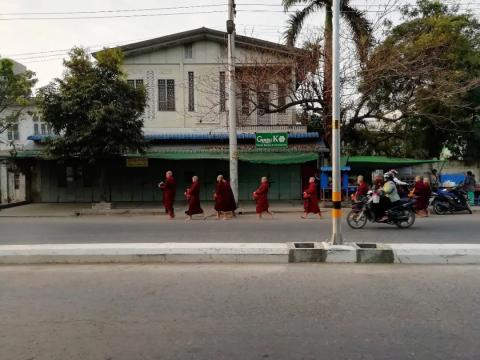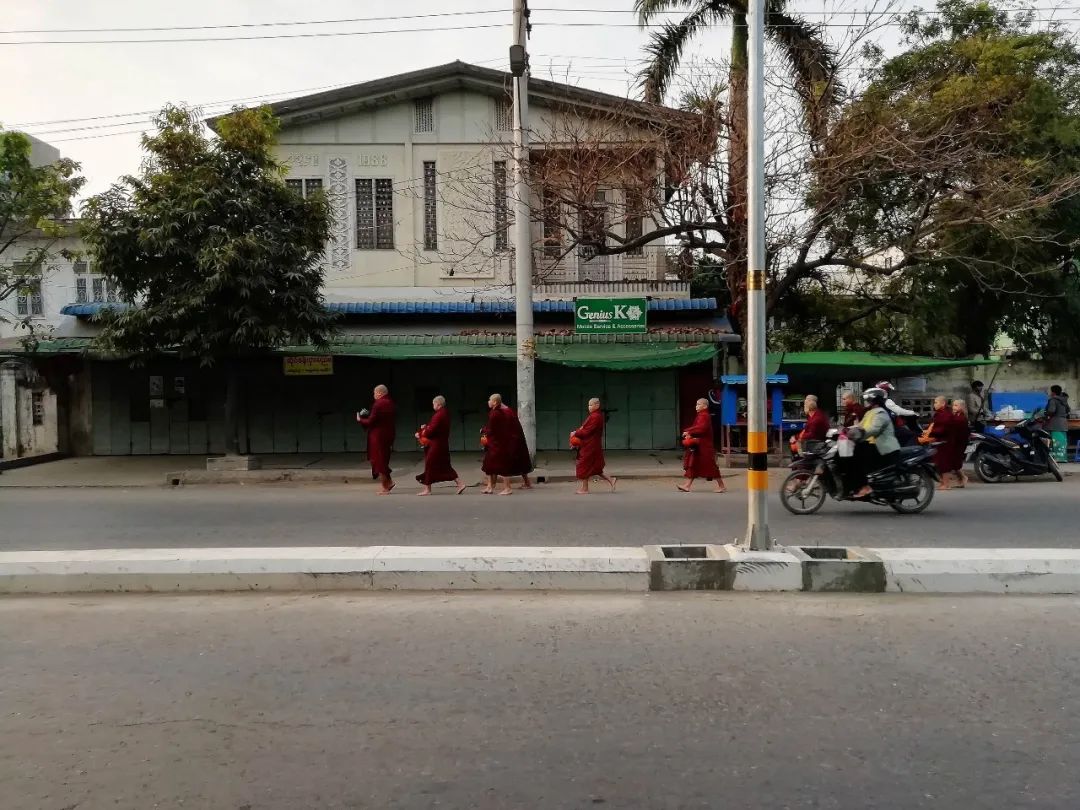
I rented a bicycle early in the morning and rode to the pier. I met a charity on the way.

I parked my bike by the dock.

On the boat to Mingun

Mingun Pier

Mingun is a satellite town of Mandalay, located on the other side of the Irrawaddy River 11 kilometers north of the city. The era of Meng Yun, the sixth king of the Konbaung Dynasty 200 years ago, was the last golden age in Myanmar's history, economically and culturally. Reaching its peak, he carried out extensive construction work and built a series of temples, pagodas and other super projects here, forming the ancient city of Mingun. Later, after being devastated by earthquakes and wars, the ancient city of Mingong lost its prosperity and became an ordinary small riverside town.

After getting off the boat, I walked north along the road

This is the Sat Taw Yar Pagoda, built in 1811. The temple has Buddha's feet carved in stone. Next to it are specimens of the ship from that time.



Not far to the north is Mingun Pathtodawgyi, which was built under the order of King Meng Yun. He once wanted to build the pagoda higher than Mandalay Mountain (more than 150 meters), but due to earthquakes and folk rumors of " The message "When the pagoda is completed, the dynasty is destroyed" caused the project to stagnate for a time. It was not until the subsequent earthquake that the construction was abandoned. Only one-third of the work was completed. What remains is a 50-meter-high pagoda base.


The entire pagoda is built of red bricks. It was the largest brick building in the world at that time. There are two huge stone lion sculptures in front of the pagoda. The front is still intact, but large cracks have appeared on the back and sides, and some locations have collapsed.



The pagoda has a door on all four sides, and only the front door is open.




You need to take off your shoes and socks when entering the main entrance. There is a Buddha statue inside

Continue walking north and pass by a temple

Next to it is the red temple, which houses the Mingun Bell, which weighs about 90 tons and is the largest uncracked bell in the world. The big bell was originally planned to be placed on the Mingun Pagoda after it was repaired, but because the tower was not completed in the end, a pavilion had to be built next to it and hung up. The iron frame used in the current clock was rebuilt in 1896.


Further north is the Hsunbyume Pagoda, which was built to commemorate Princess Hsunbyume Paya, the first queen of King Meng. The pagoda is all white and stacked layer by layer. The body of the pagoda is surrounded by a wavy seven-story pagoda base. , looks like a huge cream cake from a distance, so it is also known as the "cream cake tower".


The base of the first floor of the three-story tower has multiple groups of seven-story towers from bottom to top, symbolizing the seven mountains surrounding the world, while the wavy guardrails connecting them represent the ocean.

There are many steps leading to the second floor. The second floor of the pagoda is a huge platform.











There are many pagodas enshrining small Buddha statues on the third floor.




There are villages surrounding these pagodas. The children are not rich, but they are very simple.

The girls' faces are covered with a kind of "sunscreen", which is a good thing called Thanaka wood. Myanmar people have used it for beauty for thousands of years.


Taking a local boat back to Mandalay Pier again, I accidentally escaped the "ticket" of Mingong, and the boat ticket was much cheaper than the cruise ship.


Then I rode to the Royal Palace. The palace is square in shape with a circumference of 3.2 kilometers. There is a moat and city wall surrounding it. I first circled the moat. The moat is more than 100 meters wide and has the feel of the Forbidden City in Beijing.
Schematic map of attractions near the Royal Palace and Mandalay Hill (Qingyou)

moat


Turret and bridge



The perimeter of the moat has been opened up as a greenway for citizens to relax and exercise.


Mandalay Palace Mandalay Palace is located in the city and is the royal palace of the last dynasty of Myanmar. The original building was completely destroyed during World War II. In 1989, the Myanmar government rebuilt it on the original site based on historical data. There are four main entrances and eight side entrances.
The entrance to the palace is at the east gate. After entering, you have to walk about one kilometer to reach the core area of the palace. Visitors can only take the "designated route". There are several small pagodas on the roadside.




The entrance to the core area is a triangular-topped pagoda.



Schematic diagram of the core area of the palace

Passing through a corridor supported by several pillars, you enter the courtyard in the core area.

There are 104 large and small palaces in the palace, including the living rooms of the emperor and his concubines, the main hall where the emperor and ministers discuss matters, bathing rooms, etc. All buildings are made of teak and are red, with some gold paint strokes on the top. The palaces are arranged neatly









Various functional buildings







There is basically no furniture or furnishings in the palace. The only remaining parts are concentrated in the Cultural Museum Mandalay, which contains photos of the last emperor of the Konbaung Dynasty and his concubines, and the dragon bed where the emperor slept (this can be Lie on it and take pictures), a small amount of furniture and ornaments.









There is also a watchtower in the palace from which you can have a bird's eye view of the entire palace.






After leaving the palace, I came to the unique monastery Atumashi Kyaung. This is a teak building built by King Mindon in 1857. It was burned down in 1890 and replaced with a cement skeleton in 1966. You need to climb a dozen steps to the main entrance, and then go to the corridor outside the main hall. The entire building is mainly white walls, with golden wood carvings on the doors, windows and top. The style looks similar to a European cathedral from a distance.




The interior of the main hall is mainly a place for chanting sutras and chanting Buddha. There is basically nothing except the pillars. It is similar to an indoor sports field and looks empty.



Not far to the east of the unique monastery is the Golden Palace Monastery Shwenandaw Kyaung, which is the palace of King Mindon and the place where he died. The entire building has three floors. The bottom is supported by hundreds of teak columns, forming a suspended elevated chassis. The main hall on the first floor is surrounded by a circle of wooden corridors; the two floors that converge upwards have four floors around the perimeter. eaves. The outer door walls and columns of the main hall are equipped with exquisite carvings, which is dazzling; while the inner walls and roofs are painted with golden wall paint.








Go north and pass a bell tower.

Then we arrived at Kuthodaw Paya, which is called "the largest meritorious pagoda in the world" by the Burmese. The pagoda was built in 1857. When its construction was completed, King Mindon summoned 2,400 eminent monks from all over the Indochina Peninsula. The fifth revision conference of Buddhist scriptures was completed here. These revised Buddhist scriptures were inscribed in Pali script on 729 cloud stone steles. Due to their complete content and grand scale, these scriptures are known as "the largest books in the world". Later generations built them around each stone stele. The small white pagodas are neatly arranged and quite spectacular.






Kudu Tao Pagoda is a golden pagoda in Chinese and English.

Each entrance to the east, west, north and south is a "gatehouse" built of teak.


Then I parked my bike at the gate of Mandela Mountain, took off my shoes, put them in my bag, and started going up the mountain.

Mandalay Hill is located in the north of the city and is 236 meters high. It is the highest hill in Mandalay. Legend has it that more than 2,000 years ago, Buddha Sakyamuni preached Buddhism here and attracted countless Buddhist believers. Become famous. To reach the top, you need to go through more than 1,700 covered steps, and there are many temples and temples along the way.



There is a temple halfway up the mountain where three relics of the Buddha are enshrined. Standing is a gilded statue of Shiiya Stupa pointing towards the Grand Palace.

I finally climbed to the top of the mountain. There was an Indian temple here, with square columns connected to the vaulted roof to form a circular corridor. All the walls and columns were covered with glass, sparkling in the sunlight.




Standing on the top of the mountain, you can overlook the entire Mandalay City. It was sunset, and I just happened to catch it.


It was already dark when I came down the mountain. I rode past the moat and just happened to catch the light fountain.

The next day I continued cycling around the city. I first came to the Ein Daw Yar Pagoda near the hotel.




This is a snake temple



another temple nearby



Except for the ancient monuments, the market in Mandalay is chaotic.

bus station

bell tower

Agricultural Market

There is really nothing to do in the city, so let’s go to the temple at the foot of Mandalay Mountain.
Kyauktawgyi Paya is located at the southern entrance of Mandalay Hill. It was built from 1853 to 1878. The Buddha statue enshrined is carved from a single block of marble weighing 800 tons. It is said that it took a total of 13 days and tens of thousands of workers to transport this marble from the Irrawaddy River. The inner walls and stone pillars of the pagoda are all inlaid with small diamond-shaped pieces of glass, which look magnificent under the sunlight and lights. There are 80 small pagodas around the main pagoda, each with a Buddha statue inside. However, in order to protect the Buddha statues from damage by travelers, they are all closed with iron doors.









Not far to the east is Sandanmani Paya, which was built in 1866 by King Mindon in memory of his murdered brother. The layout of the temple is similar to that of Kudu Tao Pagoda. Several small white pagodas containing stone tablets surround a golden pagoda, forming a white square array. There are golden bells on the top of each tower. The breeze blows and the bells ring, as if King Mindong is expressing his condolences to his younger brother.








south pool

In the evening I came to the moat again to enjoy the sunset over the palace


In the evening I came to the Puppet Theater. The Mandalay Puppet Theater was founded in 1990 and has performed in dozens of countries around the world. It can be regarded as the highest level of Myanmar puppet theater. The theater is very small and can only accommodate a few dozen people. The performance lasts about two hours and you can hear Myanmar's unique string instruments: phoenix head and harp.
Puppetry is the national quintessence of Myanmar. Its content is mostly based on myths, legends and Buddhist stories. Myanmar's string puppets integrate local folk customs, national history and traditional operas, combined with unique music, to form a unique local art form. .


Puppet display

Live demonstration of operating puppets after the performance

The next day I rushed to the airport and headed to Kunming, thus ending my fifty-day trip to four countries.
Mandalay Airport


